Invulnerability of the Urban Agglomeration Integrated Passenger Transport Network under Emergency Events
Abstract
1. Introduction
2. Methods
2.1. The Modeling Method
2.1.1. The Intercity Network
2.1.2. The Integrated Network
2.1.3. Network Functional Properties
2.2. The Invulnerability Analysis Method
2.2.1. Attack Modes
2.2.2. Invulnerability Evaluation Indicators
2.2.3. Invulnerability Simulation Process of Attacking Nodes
- Step 1: The network is initialized, after that the initial weighted adjacency matrix is obtained, and the initial network impedance efficiency is calculated.
- Step 2: The attack strategies, attack modes, and attack sequence are determined. If it is the random attack strategy, the node number sequence is randomly determined, and the set of the node attack sequence is . If it is the node-numbered attack in the deliberate attack strategy, the set of the node attack sequence is . If it is the node-weighted attack in the deliberate attack strategy, , the set of the node attack sequence is .
- Step 3: The set of the attack sequence is inputted to determine the total number of iterations .
- Step 4: , which means attacking node .
- Step 5: Node is attacked. The weighted adjacency matrix , for any , .
- Step 6: The relative impedance efficiency of the network is calculated and added to the set .
- Step 7: The judgment of attack end. If , and go to Step 5. On the other hand, go to Step 8.
- Step 8: The set is outputted, and the trend chart of the network’s relative impedance efficiency under different attack modes is drawn, and the invulnerability simulation is finished.
3. The Case Study
3.1. The Integrated Passenger Transport Network in Chengdu-Chongqing Urban Agglomeration
3.2. Invulnerability Simulation of Attacking Nodes Randomly
3.3. Invulnerability Simulation of Attacking Nodes Deliberately
4. Conclusions
- (1)
- Under multiple random attacks, the network performance changes in a similar trend. The network does not collapse quickly, showing certain damage resistance and robustness, but the network performance will be greatly affected.
- (2)
- The network performance in the early stage of the node-weighted attack is lower than that of the random attack, and the network performance in the later stage is slightly higher than that of the random attack. Therefore, a network with a lower performance may be better than a network with a higher performance in terms of invulnerability, and the network performance and invulnerability are not necessarily positively correlated.
- (3)
- There is no obvious relationship between the node weight and the node-single attack result. The failure of some large-scale nodes may have a greater impact on the network performance, and the failure of individual nodes on small scales may also have a greater impact on the network performance, which reflects the complexity of the integrated passenger transport network in the urban agglomeration, so it is necessary to strengthen the supervision and maintenance of these stations or coordinate with other modes of transport for optimization.
- (4)
- The nodes in Chengdu and Chongqing play an important role in maintaining the network performance, which reflects the dual core status of Chengdu and Chongqing in the Chengdu–Chongqing urban agglomeration. It also shows from the side that the integrated development of the Chengdu–Chongqing urban agglomeration is not balanced, and there is a collapse in the middle, so it is necessary to strengthen the development and support of other cities.
Author Contributions
Funding
Institutional Review Board Statement
Informed Consent Statement
Data Availability Statement
Conflicts of Interest
References
- Albert, R.; Jeong, H.; Barabasi, A.L. Error and attack tolerance of complex networks. Nature 2000, 406, 378–382. [Google Scholar] [CrossRef] [PubMed]
- Li, C.; Yang, Z.; Zhu, Y. Invulnerability simulation of urban agglomeration passenger transport network under incomplete information attack strategy. Adv. Civ. Eng. 2021, 2021, 6658299. [Google Scholar] [CrossRef]
- Liu, Q.; Chen, H.; Zhou, J.; Lian, B. Research on invulnerability of expressway network based on complex network theory. Highway 2014, 59, 214–219. [Google Scholar]
- Xu, Z.; Zhang, Q.; Chen, D.; He, Y. Characterizing the connectivity of railway networks. IEEE Trans. Intell. Transp. Syst. 2020, 21, 1491–1502. [Google Scholar] [CrossRef]
- Luo, D.; Cats, O.; van Lint, H. Can passenger flow distribution be estimated solely based on network properties in public transport systems? Transportation 2020, 47, 2757–2776. [Google Scholar] [CrossRef]
- Wang, W.; Wang, Y.; Correia, G.; Chen, Y. A network-based model of passenger transfer flow between bus and metro: An application to the public transport system of Beijing. J. Adv. Transp. 2020, 2020, 6659931. [Google Scholar] [CrossRef]
- Zhang, X.; Zhao, S.; Mei, H. Analysis of airport risk propagation in Chinese air transport network. J. Adv. Transp. 2022, 2022, 9958810. [Google Scholar] [CrossRef]
- Zhou, Y.; Zhang, L.; Chiaradia, A.J. Estimating wider economic impacts of transport infrastructure investment: Evidence from accessibility disparity in Hong Kong. Transp. Res. Pt. A Polic. Pract. 2022, 162, 220–235. [Google Scholar] [CrossRef]
- Yang, Y.; Liu, W.; Xu, X. Identifying Important Ports in Maritime Silk Road Shipping Network from Local and Global Perspective. Transp. Res. Rec. 2022, 2676, 798–810. [Google Scholar] [CrossRef]
- Wu, C.; Kim, I. Analyzing the structural properties of bike-sharing networks: Evidence from the United States, Can-ada, and China. Transp. Res. Pt. A Polic. Pract. 2020, 140, 52–71. [Google Scholar] [CrossRef]
- Abdelaty, H.; Mohamed, M.; Ezzeldin, M.; El-Dakhakhni, W. Quantifying and classifying the robustness of bus transit networks. Transp. A 2020, 16, 1176–1216. [Google Scholar] [CrossRef]
- Bombelli, A.; Santos, B.F.; Tavasszy, L. Analysis of the air cargo transport network using a complex network theory perspective. Transp. Res. Pt. E Logist. Transp. Rev. 2020, 138, 101959. [Google Scholar] [CrossRef]
- Soh, H.; Lim, S.; Zhang, T.; Fu, X.; Lee, G.K.K.; Hung, T.G.G.; Di, P.; Prakasam, S.; Wong, L. Weighted complex network analysis of travel routes on the Singapore public transportation system. Physica A 2010, 389, 5852–5863. [Google Scholar] [CrossRef]
- Xing, Y.; Lu, J.; Chen, S. Weighted complex network analysis of shanghai rail transit system. Discret. Dyn. Nat. Soc. 2016, 2016, 1290138. [Google Scholar] [CrossRef]
- Jia, J.; Chen, Y.; Chen, N.; Yao, H. Identifying key bus stations based on complex network theory considering the hybrid influence and passenger flow: A case study of Beijing, China. Adv. Civ. Eng. 2020, 2020, 8824797. [Google Scholar] [CrossRef]
- Wu, M.; Wang, Z.; Gan, X.; Yang, G. Identification of key flight conflict nodes based on complex network theory. J. Northwest. Polytech. Univ. 2020, 38, 279–287. [Google Scholar] [CrossRef]
- Liu, S.; Li, Z.; Zhong, J.; Li, D. Percolation transition in temporal airport network. Chin. J. Aeronaut. 2020, 33, 223–230. [Google Scholar] [CrossRef]
- Zhang, X.; Zhang, W.; Lee, P.T.W. Importance rankings of nodes in the China Railway Express network under the Belt and Road Initiative. Transp. Res. Pt. A Polic. Pract. 2020, 139, 134–147. [Google Scholar] [CrossRef] [PubMed]
- Hamedmoghadam, H.; Jalili, M.; Vu, H.L.; Stone, L. Percolation of heterogeneous flows uncovers the bottlenecks of infrastructure networks. Nat. Commun. 2021, 12, 1254. [Google Scholar] [CrossRef]
- Angeloudis, P.; Fisk, D. Large subway systems as complex networks. Physica A 2005, 367, 553–558. [Google Scholar] [CrossRef]
- Liu, C.; Lv, Y.; Liu, B.; Li, Q. Cascading failure resistance of urban rail transit network. J. Transp. Syst. Eng. Inf. Technol. 2018, 18, 82–87. [Google Scholar] [CrossRef]
- Li, T.; Rong, L.; Yan, K. Vulnerability analysis and critical area identification of public transport system: A case of high-speed rail and air transport coupling system in China. Transp. Res. 2019, 127, 55–70. [Google Scholar] [CrossRef]
- Yap, M.D.; Oort, N.; Nes, R.; Arem, B. Identification and quantification of link vulnerability in multi-level public transport networks: A passenger perspective. Transportation 2018, 45, 1161–1180. [Google Scholar] [CrossRef]
- Sohn, J. Evaluating the significance of highway network links under the flood damage: An accessibility approach. Transp. Res. Pt. A Polic. Pract. 2006, 40, 491–506. [Google Scholar] [CrossRef]
- Zhang, J.; Wang, S.; Wang, X. Comparison analysis on vulnerability of metro networks based on complex network. Physica A 2018, 496, 72–78. [Google Scholar] [CrossRef]
- Latora, V.; Marchiori, M. Vulnerability and protection of infrastructure networks. Phys. Rev. E 2005, 71, 015103. [Google Scholar] [CrossRef] [PubMed]
- Cats, O.; Krishnakumari, P. Metropolitan rail network robustness. Physica A 2020, 549, 124317. [Google Scholar] [CrossRef]
- Mattsson, L.G.; Jenelius, E. Vulnerability and resilience of transport systems—A discussion of recent research. Transp. Res. Pt. A Polic. Pract. 2015, 81, 16–34. [Google Scholar] [CrossRef]
- Mou, N.; Sun, S.; Yang, T.; Wang, Z.; Zheng, Y.; Chen, J.; Zhang, L. Assessment of the Resilience of a Complex Network for Crude Oil Transportation on the Maritime Silk Road. IEEE Access 2020, 8, 181311–181325. [Google Scholar] [CrossRef]
- Xu, Z.; Chopra, S.S.; Lee, H. Resilient Urban Public Transportation Infrastructure: A Comparison of Five Flow-Weighted Metro Networks in Terms of the Resilience Cycle Framework. IEEE Trans. Intell. Transp. Syst. 2022, 23, 12688–12699. [Google Scholar] [CrossRef]
- Hassan, R.; Yosri, A.; Ezzeldin, M.; El-Dakhakhni, W. Robustness quantification of transit infrastructure under systemic risks: A hybrid network-analytics approach for resilience planning. J. Transp. Eng. Pt. A-Syst. 2022, 148, 4022089. [Google Scholar] [CrossRef]
- Sun, R.; Zhu, G.; Liu, B.; Li, X.; Yang, Y.; Zhang, J. Vulnerability analysis of urban rail transit network considering cascading failure evolution. J. Adv. Transp. 2022, 2022, 2069112. [Google Scholar] [CrossRef]
- Liu, C.; Yin, H.; Sun, Y.; Wang, L.; Guo, X. A Grade Identification Method of Critical Node in Urban Road Network Based on Multi-Attribute Evaluation Correction. Appl. Sci. 2022, 12, 813. [Google Scholar] [CrossRef]
- Liu, S.; Yin, C.; Chen, D.; Lv, H.; Zhang, Q. Cascading failure in multiple critical infrastructure interdependent networks of syncretic railway system. IEEE Trans. Intell. Transp. Syst. 2022, 23, 5740–5753. [Google Scholar] [CrossRef]
- Chen, M.; Lu, H. Analysis of transportation network vulnerability and resilience within an urban agglomeration: Case study of the greater bay area, China. Sustainability 2020, 12, 7410. [Google Scholar] [CrossRef]
- Liu, J.; Lu, H.; Ma, H.; Liu, W. Network vulnerability analysis of rail transit plans in Beijing-Tianjin-Hebei Region considering connectivity reliability. Sustainability 2017, 9, 1479. [Google Scholar] [CrossRef]
- Li, C.; Wei, L.; Hao, Y. Research on characteristics of city agglomeration compound traffic network. J. Syst. Simul. 2016, 28, 2958–2965. [Google Scholar] [CrossRef]
- Li, C.; Zhang, S.; Yang, Z.; Liu, Z. Invulnerability simulation in urban agglomeration passenger traffic network under targeted attacks. J. Transp. Syst. Eng. Inf. Technol. 2019, 19, 14–21. [Google Scholar] [CrossRef]
- Guan, W.; Wu, J.; Gao, Z. Transportation network systems engineering. J. Transp. Syst. Eng. Inf. Technol. 2020, 20, 9–21. [Google Scholar] [CrossRef]
- Meng, Y.; Tian, X.; Li, Z.; Zhou, W.; Zhou, Z.; Zhong, M. Comparison analysis on complex topological network models of urban rail transit: A case study of Shenzhen Metro in China. Physica A 2020, 559, 125031. [Google Scholar] [CrossRef]
- Lv, B.; Guan, X.; Gao, Z. Evaluation and optimal recovery strategy of metro network service resilience. J. Transp. Syst. Eng. Inf. Technol. 2021, 21, 198–205. [Google Scholar] [CrossRef]
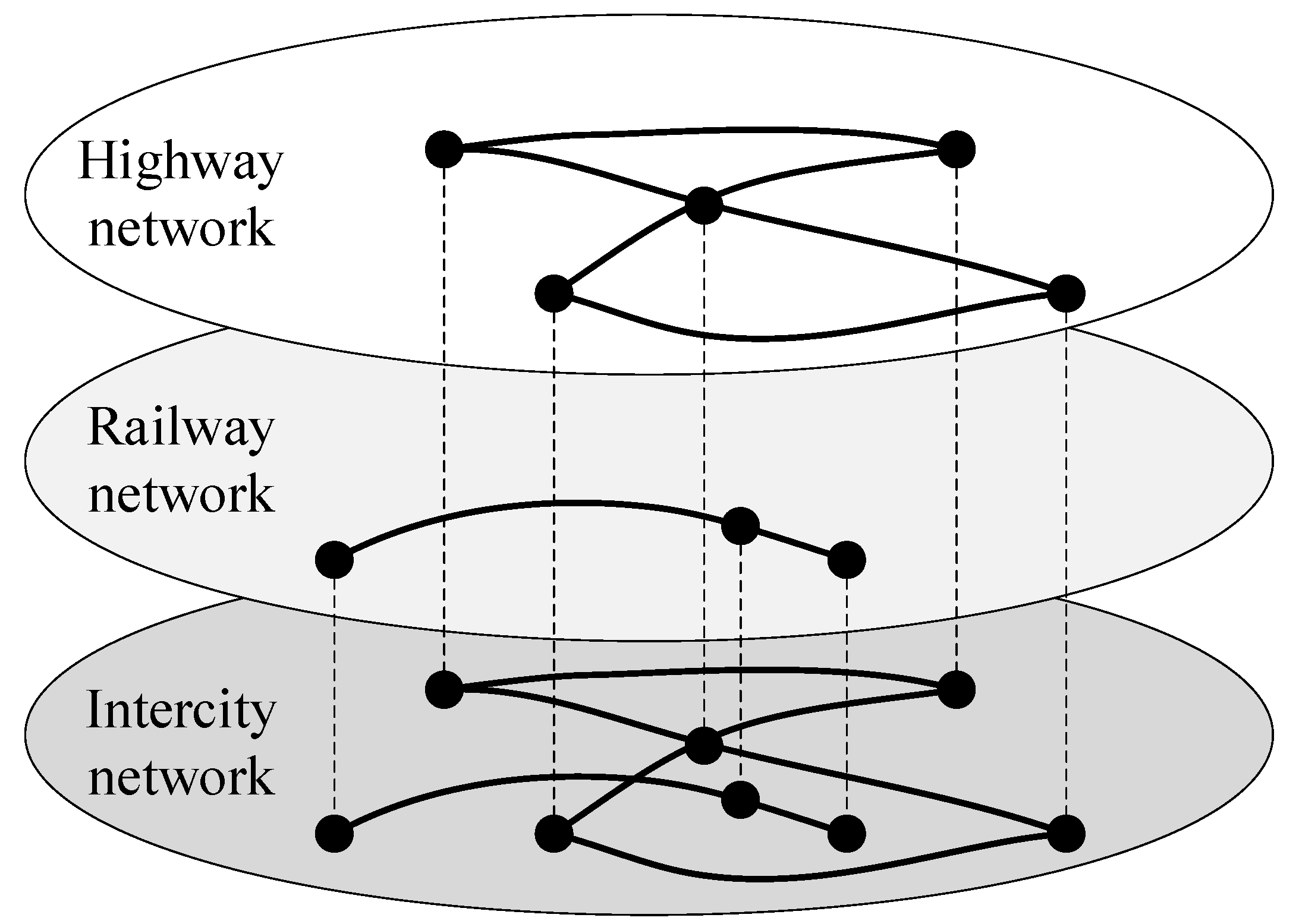
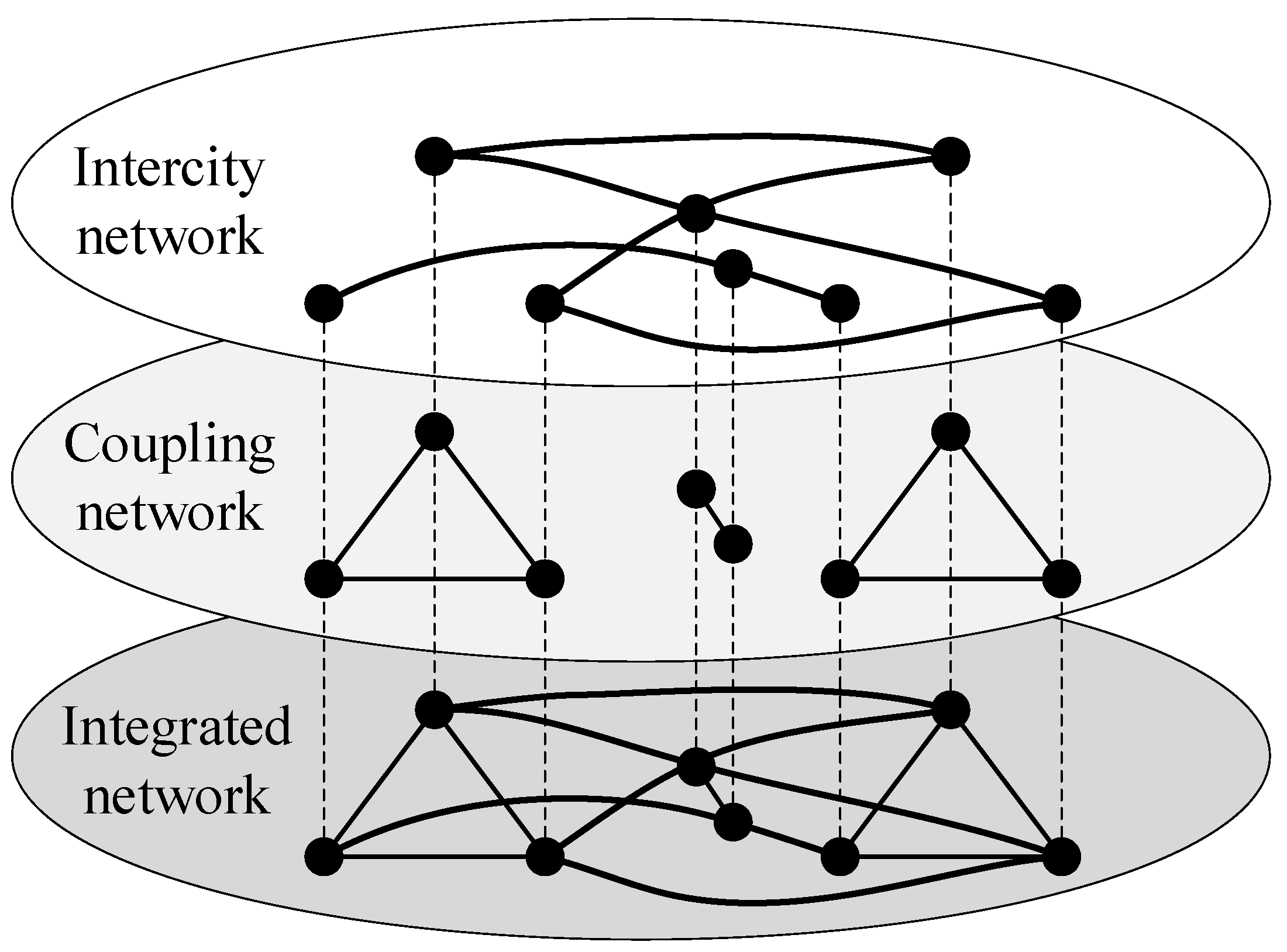

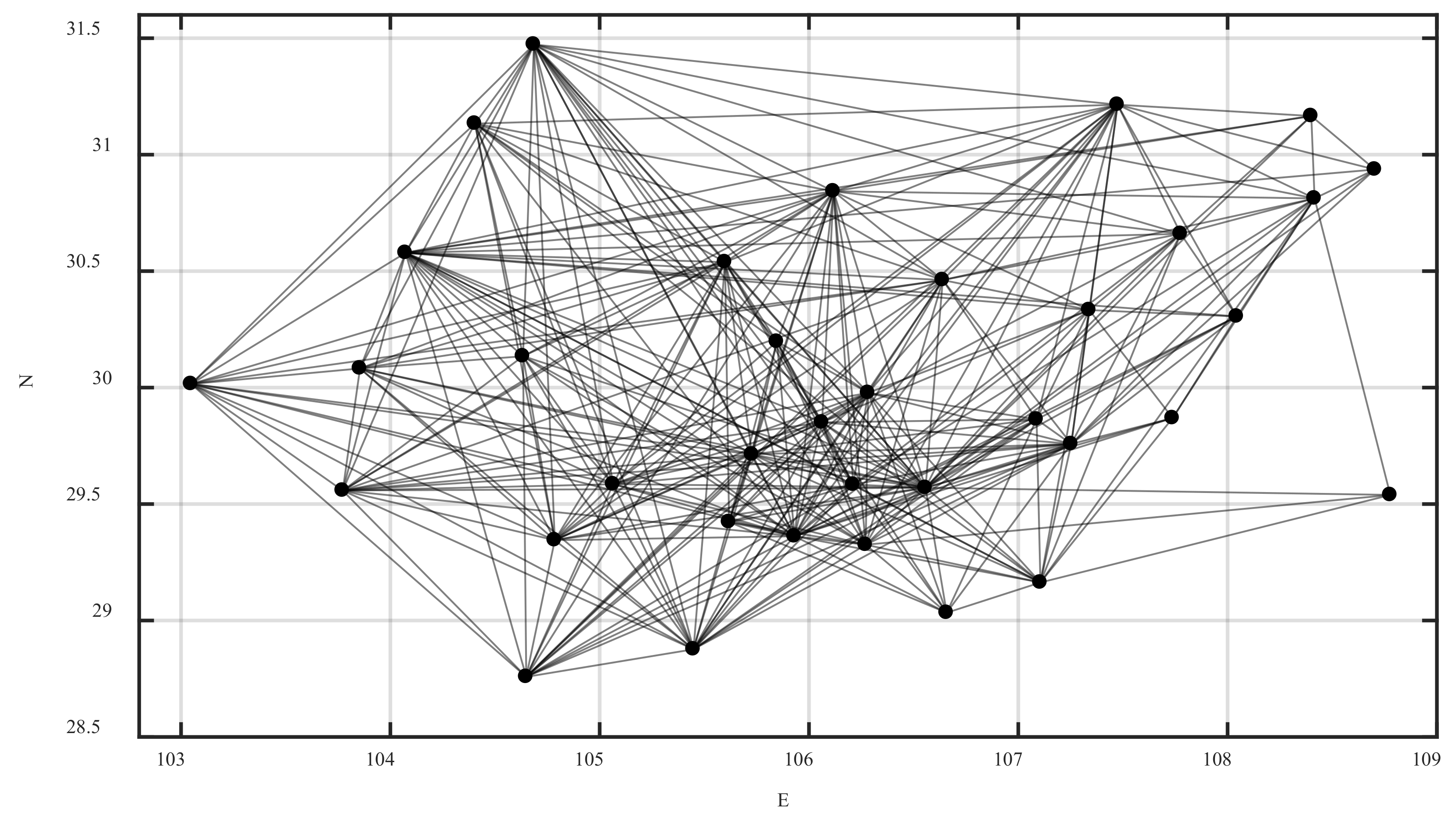

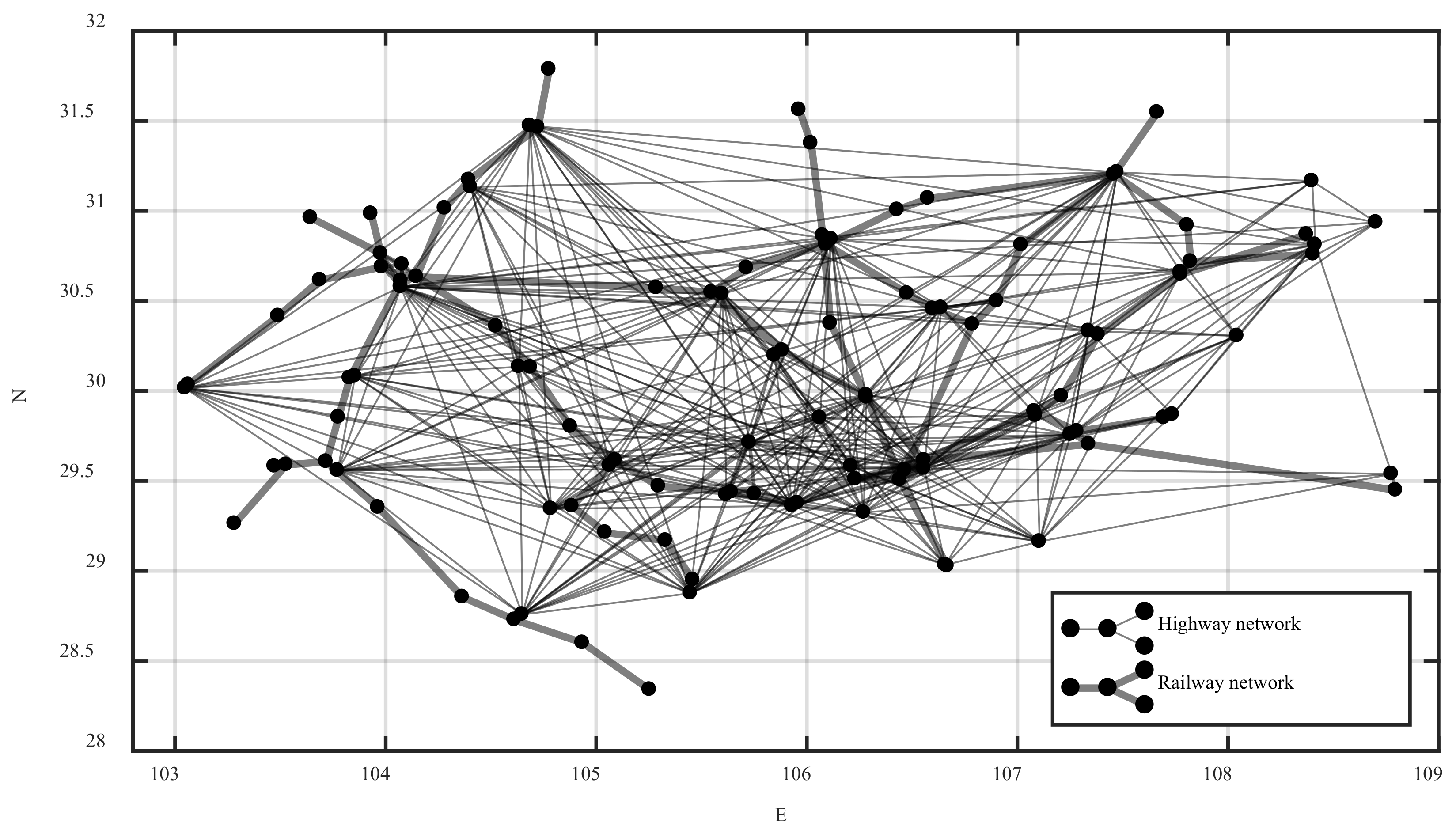


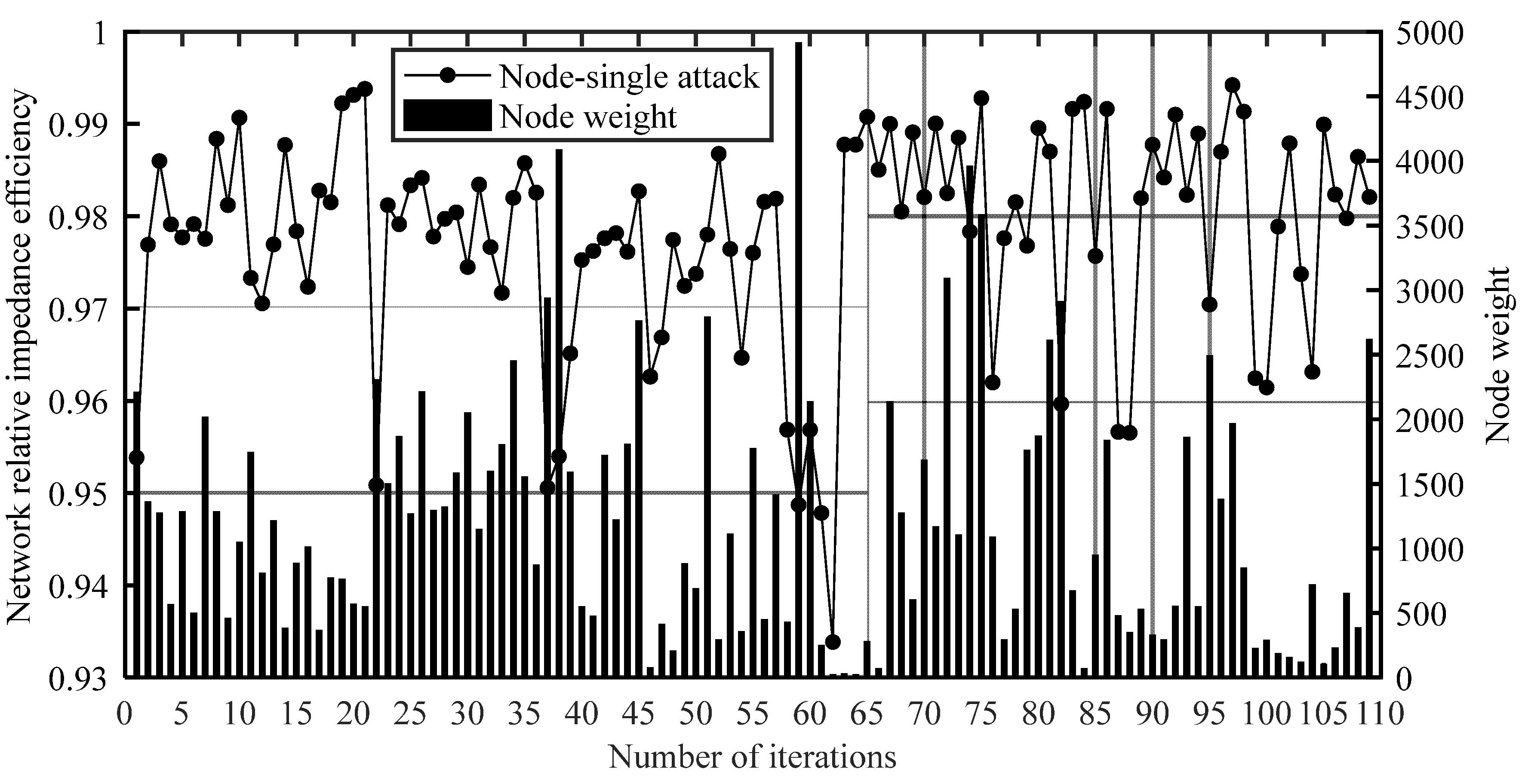
| Sort (Number) | Node | Relative Impedance Efficiency |
|---|---|---|
| 1 (62) | Xipu Railway Station | 0.933869143 |
| 2 (61) | Chengdu West Railway Station | 0.947845321 |
| 3 (59) | Chengdu East Railway Station | 0.948733038 |
| 4 (37) | Chongqing North Railway Station | 0.950581884 |
| 5 (22) | Chengdu Highway Station | 0.950873039 |
| 6 (01) | Chongqing Highway Station | 0.953840324 |
| 7 (38) | Chongqing West Railway Station | 0.953985546 |
| Sort (Number) | Node | Relative Impedance Efficiency |
|---|---|---|
| 109 (97) | Xingwen Railway Station | 0.994211444 |
| 108 (21) | Yunyang Highway Station | 0.993794890 |
| 107 (20) | Kaizhou Highway Station | 0.993136849 |
| 106 (75) | Jiangyou Railway Station | 0.992790545 |
| 105 (84) | Ebian Railway Station | 0.992396994 |
| 104 (19) | Zhongxian Highway Station | 0.992233333 |
| 103 (83) | Qianwei Railway Station | 0.991630945 |
Disclaimer/Publisher’s Note: The statements, opinions and data contained in all publications are solely those of the individual author(s) and contributor(s) and not of MDPI and/or the editor(s). MDPI and/or the editor(s) disclaim responsibility for any injury to people or property resulting from any ideas, methods, instructions or products referred to in the content. |
© 2022 by the authors. Licensee MDPI, Basel, Switzerland. This article is an open access article distributed under the terms and conditions of the Creative Commons Attribution (CC BY) license (https://creativecommons.org/licenses/by/4.0/).
Share and Cite
Wu, P.; Li, Y.; Li, C. Invulnerability of the Urban Agglomeration Integrated Passenger Transport Network under Emergency Events. Int. J. Environ. Res. Public Health 2023, 20, 450. https://doi.org/10.3390/ijerph20010450
Wu P, Li Y, Li C. Invulnerability of the Urban Agglomeration Integrated Passenger Transport Network under Emergency Events. International Journal of Environmental Research and Public Health. 2023; 20(1):450. https://doi.org/10.3390/ijerph20010450
Chicago/Turabian StyleWu, Peng, Yunfei Li, and Chengbing Li. 2023. "Invulnerability of the Urban Agglomeration Integrated Passenger Transport Network under Emergency Events" International Journal of Environmental Research and Public Health 20, no. 1: 450. https://doi.org/10.3390/ijerph20010450
APA StyleWu, P., Li, Y., & Li, C. (2023). Invulnerability of the Urban Agglomeration Integrated Passenger Transport Network under Emergency Events. International Journal of Environmental Research and Public Health, 20(1), 450. https://doi.org/10.3390/ijerph20010450





